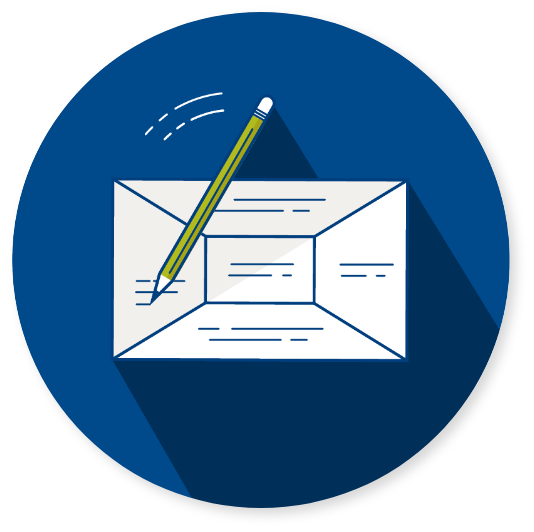The Message Box
Get Started Using
the Message Box
Download Your Own
Message Box Workbook
Join a Message Box Workshop

What is the Message Box?
A tool for crafting your message

The Message Box helps you take the information you hold in your head about your work and communicate it in a way that resonates with your chosen audience. It can help you prepare for interviews with journalists or employers, plan a presentation, outline papers or lectures, prepare grant proposals, or explain what you do and why it matters to family and friends. First, you identify your audience. Then you can move through the five sections of the Message Box in any order you choose. The most important thing is to just get started!
Based in science
Too often, scientific knowledge is locked up in professional journals. Effective science communication requires recognizing the differences between how scientists have traditionally been taught to communicate and how the rest of the world communicates. If you want your work to be relevant to audiences beyond your field of research—from journalists, to policymakers, to members of your community, or others—you need to think differently about how you communicate.
With the Message Box, we’ve built an easy-to-use tool that is informed by evidence-based core principles of effective communication.
Iterate, distill, and practice
Don’t expect your first draft to be your final draft; people often start out providing too much detail, and then refine and distill with each new version. Through each iteration, you will make choices about what’s most important, and whittle away at the language until it succinctly captures the key messages that you want to convey about your work. By the end of the process, you should have just a few points for each section.
A versatile tool for everyone
Working with us, scientists have shaped the public discourse on key issues such as ocean acidification, fisheries, water security in the American West, wildfire, ecosystem-based management, and more. Every scientist we work with starts with a Message Box. Although COMPASS focuses on researchers working at the intersection of people and nature, the Message Box is a useful tool for anyone seeking to distill what they do and why it matters for a particular audience.
Making your research accessible and relevant takes effort, but no one is better equipped to do it than you. Your passion, experience, and expertise are unique to you and policymakers, managers, journalists, and society want to hear from you!
Getting Started
Who’s Your Audience?
Every Message Box you build should be created for one specific audience—and yes, this does mean that if you’re trying to reach more than one group, you’ll need to create more than one Message Box! When you tailor your message to your audience and what matters to them, you make it easier for them to care and want to learn more.

You may already have a very specific audience in mind—like a journalist who can help raise awareness, a policymaker seeking solutions to a local problem, or communities whose livelihoods will be impacted. Everyone interprets information through their own lens. Understanding that lens allows you to frame your messages in ways that connect with them. But how do you build that understanding? By getting to know the people you’re hoping to reach.
Here are some things you might want to find out before talking to someone:
- What outlets does this journalist write for and what angle do they typically take?
- Is the policymaker an elected official who answers to constituents, or an agency official who must respond to specific legislative mandates?
- What is the focus or mission of this organization or agency?
- What issues have been primary concerns for this community recently?
Avoid trying to create a Message Box for the ‘general public’; it’s made up of many groups of people with different interests, motivations, and values. It makes it very hard to figure out what they all care about and how your work is relevant for each of them. What are your goals for communicating about your research? The answer to this question can help you identify who actually needs to know about your work.
The Message Box
After you’ve identified your audience, you’re ready to start drafting your Message Box! You can begin anywhere. Click on the sections below to learn more about each, and download a blank Message Box to print and fill out as you go.
The Solutions Section
What can be done to address the problem?
The Solution section outlines the options for solving the problem you identified. When presenting possible solutions, consider whether they are things your audience can influence or act upon. And remind yourself of your communication goals: Why are you communicating with this audience? What are you hoping they will do?
The Benefits Section
Who does this help and how?
In the Benefit section, you list the benefits of addressing the Problem — all the good things that could happen if your Solution section is implemented. This ties into the So What of why your audience cares, but focuses on the positive results of taking action (the So What may also be a negative thing—for example, inaction could lead to consequences that your audience cares about). It’s helpful to be specific here, since concrete examples are more compelling than abstract ones.
The So What? Section
How does this impact something your audience cares about?
The crux of the Message Box, and the critical question COMPASS helps scientists answer, is “So what?” Why should your audience care about your research? The answer to this question changes from audience to audience, and you’ll need to adjust accordingly. We use the analogy of putting a message through a prism that clarifies the importance to different audiences. Each audience will be interested in different facets of your work, and you want your messages to reflect their interests and meet their needs.
The Problems Section
What specific dimension of the issue are you addressing?
The Problem is the chunk of the broader Issue that you’re addressing with your work. It’s your piece of the pie, reflecting your knowledge and area of expertise. Think about your research questions: what aspect of the specific situation you’re studying would matter to your audience? The Problem is also where you describe what you’re observing and want to address (which sets up the So What section as well).
The Issue Section
What’s the big picture?
The Issue section in the center of the box identifies the overarching issue or topic that you’re addressing. This should be very concise and clear; no more than a couple of words or a short phrase, something you’d type into a search engine. It’s the broad-strokes term for your work.
Upcoming workshops
Open for registration
Building Better Virtual Events
Building Better Virtual Events
Learn tools and strategies to help your virtual events meet your communication goals.
Strategic Presentations
Strategic Presentations
Learn and practice concepts and considerations for more intentional and engaging presentations.
Do you have more questions about the Message Box?
I’ve done a Message Box, but how can I communicate better?
The best way to improve your communication skills is through practice—ideally with us! We offer the Message Box for free because we want every scientist to be able to communicate more effectively, but there’s no substitute for participating in one of our workshops and getting personalized, expert feedback from our team.
How do I know when my Message Box is done?
A Message Box is never really finished; it just keeps evolving as you use it. The Message Box principles may be simple, but it takes time to develop messages that will work for you and your audiences. Ultimately, you want to pare down your ideas so that each section is a few clear sentences. If you still have a paragraph, keep working to refine your messages. Remember, the “So what?” can vary depending on what each audience cares about. This can influence the problems you identify, the solutions you highlight and the benefits you emphasize. Once you feel you have distilled your research down to its essence, it’s time to practice your messages with someone else and get feedback on how they’re landing.
How many Message Boxes do I need to do?
One for each audience! Different audiences have different interests, needs, and values. You’ll want to reflect that in your messages.
How do I know if I’m doing it right? How long do people typically spend crafting their Message Boxes?
There isn’t a right or a wrong way to fill out the Message Box—it’s a tool, not a product. If it’s helping you hone in on what you need to say and how to say it in a way that is relevant for your audience, then you’re doing it right! Crafting your messages is an iterative process. Revisions often come from feedback when you practice with others, or conversations with your intended audience—what are you learning about their interests and values? Which messages are sticking for them (and which aren’t)? Each person’s experience is unique and changes depending on what they hope to accomplish by communicating their science and who they’re trying to share it with.
Can I share the Message Box with my colleagues?
Absolutely! We hope you will The Message Box Workbook is provided free of charge for personal and educational use only. COMPASS retains intellectual rights to all materials; please contact us at info@compassscicomm.org if you seek to use the Workbook commercially.
Share Your Message Box With Us
We invite you to share your work with your community and ours! Share on social media using the hashtag #MessageBox and don’t forget to tag @COMPASSscicomm in your post.


